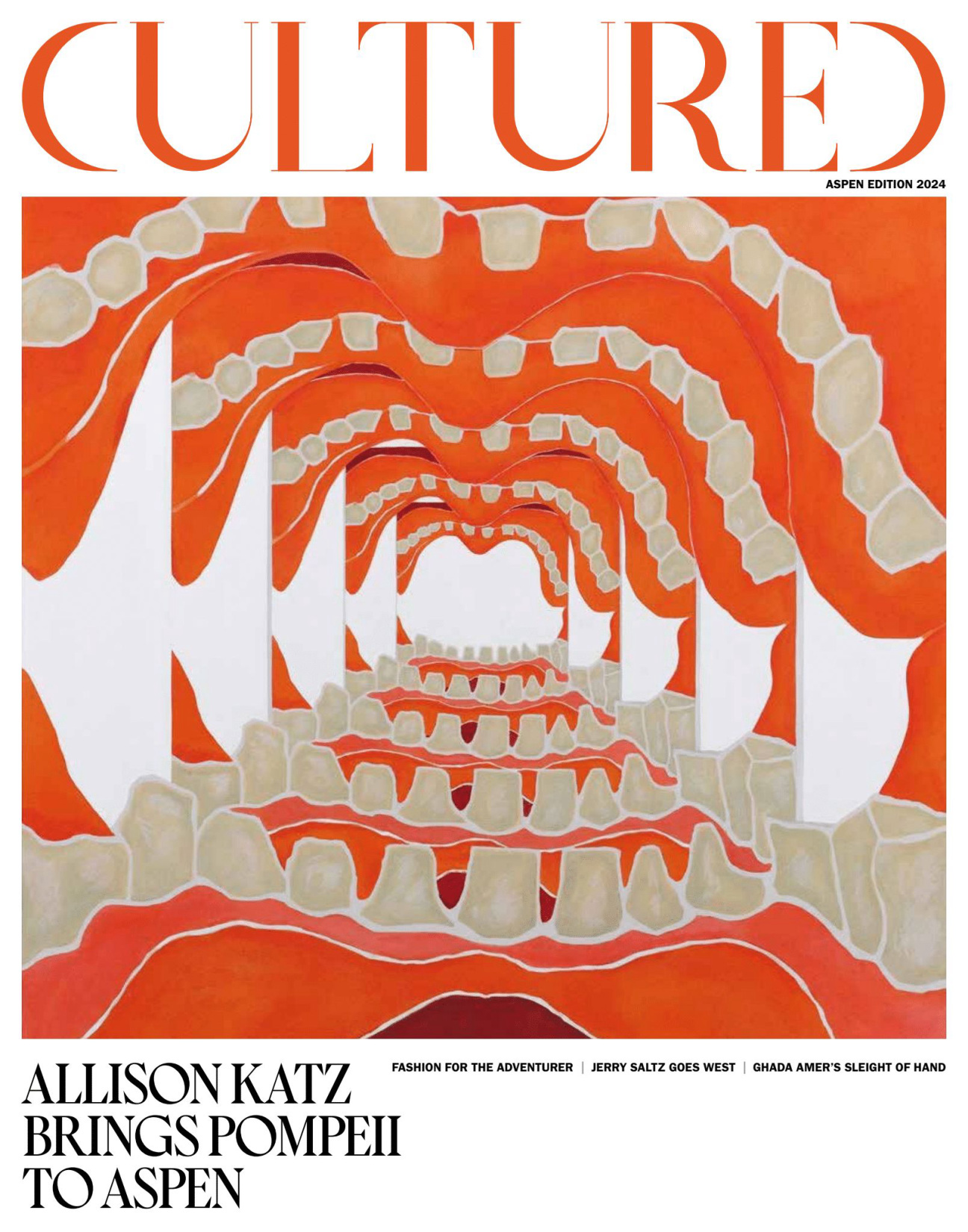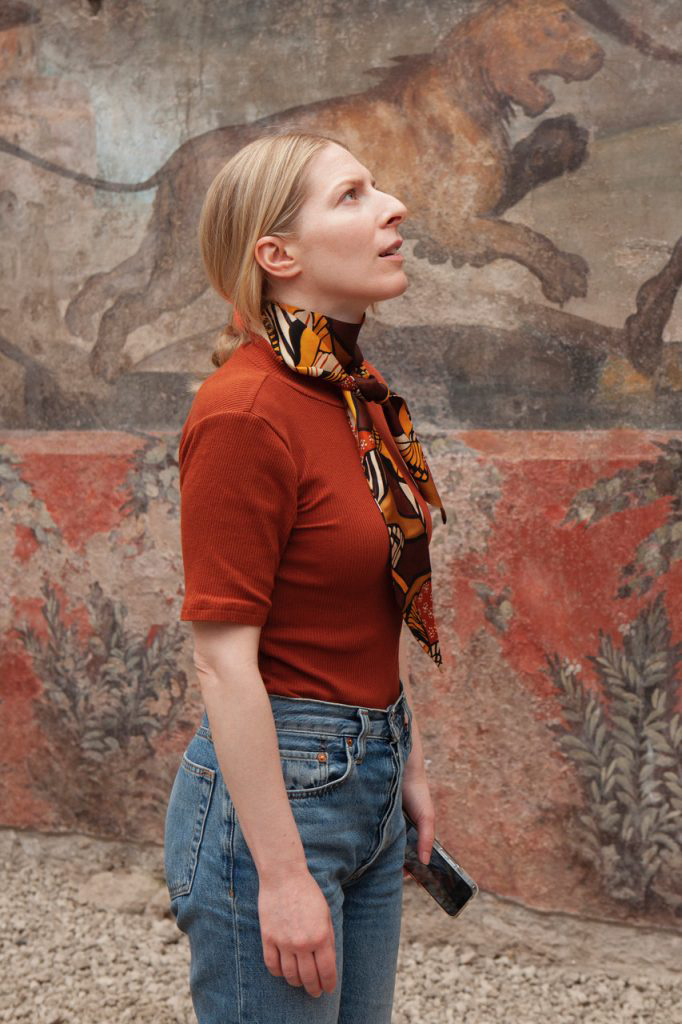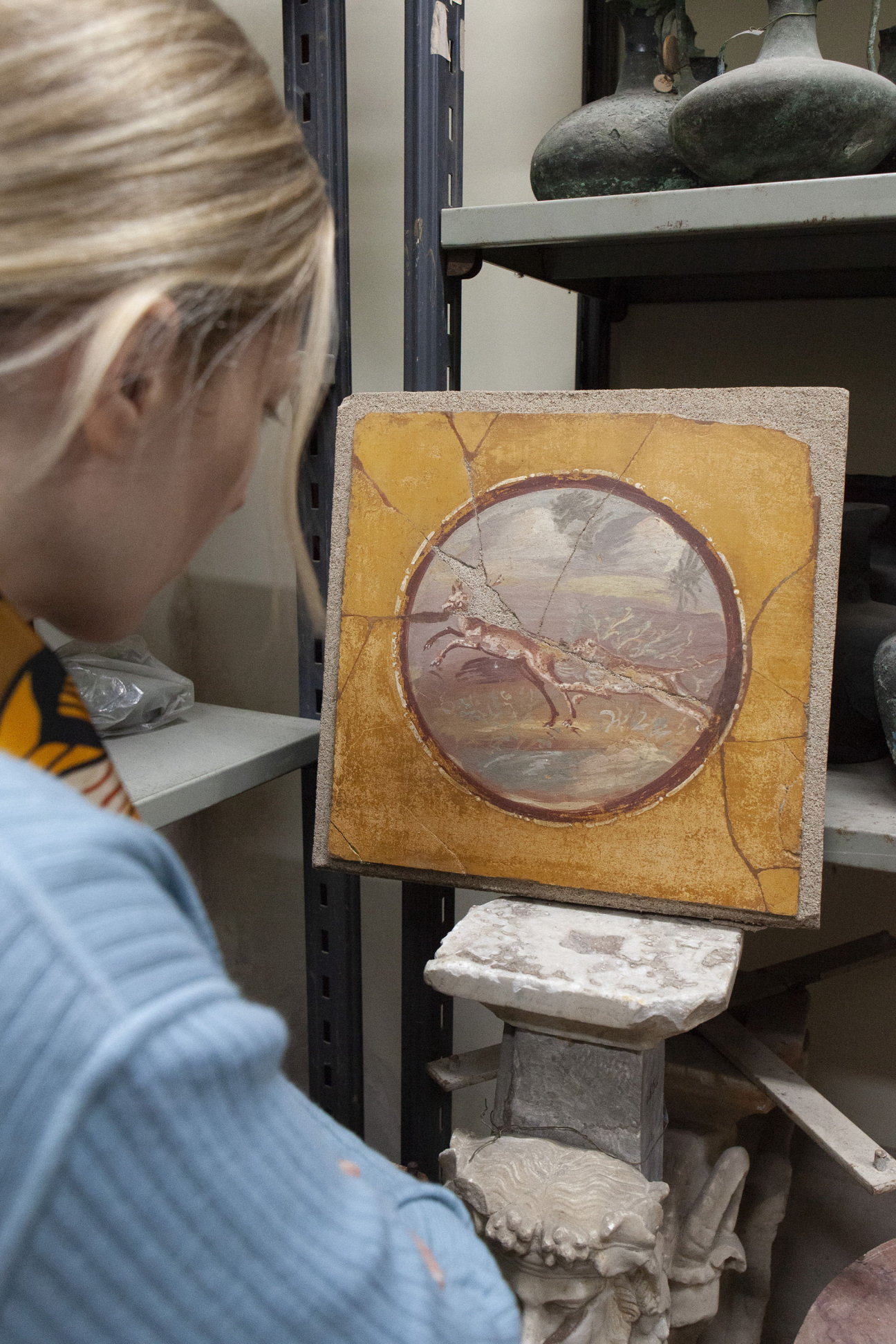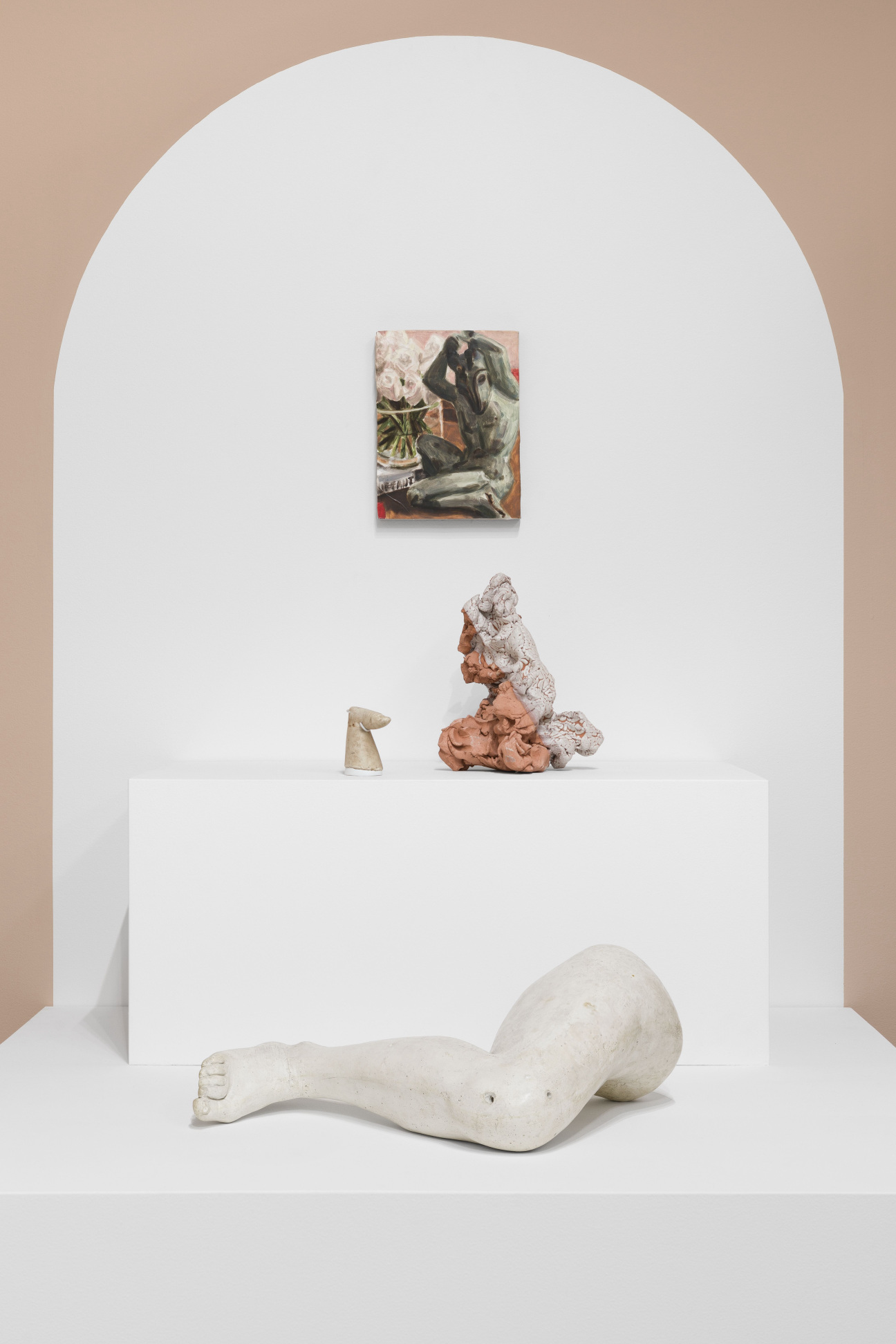
Allison Katz is not one to shy away from a challenge. The London-based painter, known for arresting works that fold examinations of the female form, domestic architecture, and pop culture symbolism into captivating interrogations of collective memory and social history, has kept busy in recent years. In addition to her participation in the 2022 Venice Biennale, Katz opened a slew of solo shows at Camden Art Centre, Canada House and Hauser & Wirth Los Angeles.
But in the last 18 months, the artist has dedicated herself to a unique pursuit. At the invitation of Nicola Lees, director of the Aspen Art Museum, Katz spent the last year and a half working in close creative partnership with curator Stella Bottai laying the groundwork for what would become “In the House of the Trembling Eye,” a multi-floor exhibition on view at the Aspen Art Museum through September 29.
Organized in collaboration with the Archaeological Park of Pompeii, the ambitious and unorthodox behemoth of an exhibition, sees Katz don the title of both curator and artist. “I came into this project with a lot of unknowns,” the artist recalls. For Lees, the undertaking—which features works by Katz alongside pieces by over 50 artists both historical and contemporary and a tantalizing series of Pompeiian fresco fragments—was an unusual one, “both for our institution and for [Allison] as an artist.”
The opening of “In the House of the Trembling Eye” marked a significant milestone for Katz, who broke into tears when she stepped into the exhibition hall for the first time. It was also a turning point for Lees, who—after turns as a curator at both Frieze London and The Serpentine Gallery—has dedicated her career to challenging the constraints of the art-viewing experience.
Here, the pair reunite to discuss their initial vision for the exhibition—which marks both the Aspen Art Museum’s 45th anniversary and the 10th anniversary of its Shigeru Ban-designed building—a memorable trip to Pompeii, and how they landed upon the show’s enigmatic title.

Nicola Lees: "In the House of the Trembling Eye" is an unprecedented exhibition, both for our institution and for you as an artist. Alongside your paintings, it features artworks that you selected from personal collections in and around Aspen as well as a series of fragments borrowed from the Archaeological Park of Pompeii.
Your concept and design for the exhibition display introduces an extraordinary architecture, inspired by the ancient Roman house, or domus, across all three floors of the museum. How did it feel to work in such a dialogic way with many players, as opposed to your usual, more solitary studio practice?
Allison Katz: I came into this project with a lot of unknowns. There was no model, so it grew organically. I approached it like a painting: when I start, Ihave this glimpse or desire of what I want, but I don’t want to overly control it. That allowed the exhibition to reflect my process and the ongoing synchronicities and research. In my mind, I was always the ideal viewer, which is a fun position to be in. It was like I was making this show for the 15-year-old budding painter version of myself who first fell in love with Pompeii.
Lees: An important component of the exhibition is the research that you carried out at the Archaeological Park of Pompeii as part of their contemporary art program Pompeii Commitment as one of the first participants in their Fellowship program in 2022-23. Last year, we returned to Pompeii together with Stella Bottai, the senior curator-at-large at AAM and one of the Curators of Pompeii Commitment. We were given access to the private archaeological storages, and the sense of proximity, intimacy even, with these fragments and artifacts is overwhelming.
Katz: It was thrilling because these materials are usually inaccessible except to archaeologists. It’s a living archive more than a storage unit; nothing is wrapped, everything is visible on shelves and in racks. There was a sense of rare permission, which led to a heightened viewing experience. Speaking with the archaeologists, spending time on the site, and understanding the role that painting played in the structure of the domus was fascinating.
I learned there was a fluidity between private and public space—it’s not a “house” as we understand the definition today. The structure was as much about shelter as it was about staging persona and projecting aspirations, lineage, and a relationship with the gods, and painting played a central role in communicating that. The museum has grown out of these mixed-use beginnings so it made sense to return to this template when making a group show with works fromlocal private collections in Aspen.

Lees: Tell me more about your organizational principles for the exhibition in Aspen, which begins “outside” with a section inspired by Via dell’Abbondanza, the “high street” of ancient Pompeii.
Katz: The show starts on the second floor of the museum and works its way down until the lower level. It begins with “The Street,” a kind of prologue, where I created a corridor perpendicular to the first room, so the viewer might feel like they are walking along outside. In Pompeii, the perspective of the passerby was crucial. The doors of the ancient house were kept open during the day, and the sightline of the interior was visible all the way to the garden at the back.
This viewpoint was deliberately staged to showcase artworks and inhabitants in a choreographed manner, including the area where the patriarch of the house would conduct his business on a slightly raised platform, like an actor in a play. The first room of the exhibition is modeled on the ancient atrium, or central courtyard, which has a hole in the roof and a reflecting pool beneath it to collect rainwater. I saw that set-up as a chance to contemplate eternity and reflection, which I think are fundamental themes of painting. Each section explores a different atmosphere and poetic logic of display, based off of the domus’s rooms and their design or function.
Lees: The exhibition features 10 fragments on loan from Pompeii. Speaking of “reflection,” tell me about the fresco fragment depicting Narcissus, displayed in the Atrium section.
Katz: Narcissus is a recurring motif in Pompeii, which became popular again during the Renaissance. The 15th-century theorist Leon Battista Alberti even proposed that Narcissus was humanity’s first painter, because of how he sees himself reflected in the pool. This idea of how the surface can be both a danger and a source of potential felt really exciting to me.
In that room, there are paintings of the sky, but there's also a floor piece by Nancy Lupo, which to me served as another reflecting pool. Its materials and form reflect glimpses of the other paintings around it, which deal with fields of sky-like compositions or portals. So the reflection is both literal and metaphorical; it's inside each painting and also among them.

Lees: Why did you choose a figurative sculpture depicting a seated male figure in the Tablinum room—a section that conjures the environment of the domestic “office”?
Katz: The sculpture, by Bharti Kher, is titled Father and is a cast of her own father with a hole through the torso. It is reminiscent of the plaster casts of bodies found in Pompeii. It is very moving to see how Kher used plaster, wax, and other materials to produce this life cast, with the addition of leaving open the space where his heart would be. The patriarch is there, but there's also a vulnerability to his presence.
Lees: There are over one hundred incredible artworks in this exhibition. How did you feel when you first walked into the galleries?
Katz: I cried, and this was still during installation, before it was even finished! There is a gap between a painting in one's mind and a painting in reality—with its objecthood, aura, and presence. It doesn't matter how many times an artwork has been seen—when it’s put into a new context or configuration, it acts differently. Our ability to show these works anew was made easier by pairing them with artifacts that are so old. We talk a lot about art as timeless, but we also want art to be of its time. There's this fascinating contradiction when something ancient engages with something contemporary.
Lees: The title of the exhibition conjures up a whole world in and of itself. What are the reasons or influences behind this title?
Katz: In Pompeii, they name houses based on a distinguishing feature. I thought, What is the distinguishing feature of Aspen? I became fascinated by the Aspen tree and the fact that it trembles—it's called the trembling or the quivering aspen, and it has eye-like markings all over its bark. This trembling also links back to Pompeii, and the trembling of the Earth caused by the volcanic eruption of Vesuvius that buried the city—which also preserved it.
As artists and curators, we’re always trying to disentangle different versions of art history, different origin mythologies, the fictions behind the surface. There’s no pure narrative in history, and the past can be as urgent and speculative as the future. We are just trembling together towards new stories.










 in your life?
in your life?

